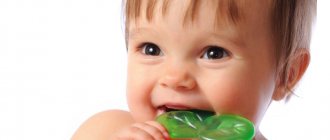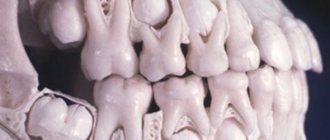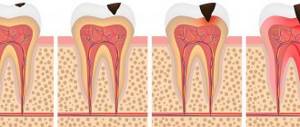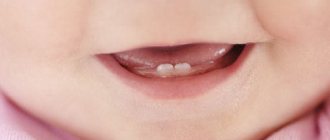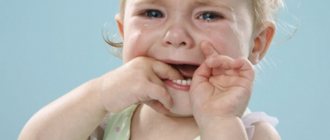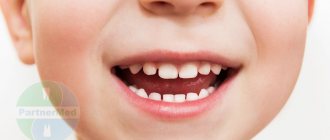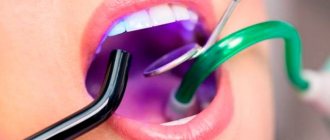Even young children are susceptible to dental diseases, since the enamel and gums of children are not yet strong enough to resist the effects of negative factors.
However, most parents believe that there is no need to treat children’s baby teeth, since they will fall out sooner or later anyway. This is an erroneous opinion, because the condition of the baby teeth largely determines what kind of molars will grow. Untreated baby teeth can serve as a source of infection. There are many reasons that worsen the condition of the oral cavity and teeth in children: poor hygiene, unlimited consumption of sweets, insufficient intake of vitamins. Against the background of these reasons, immunity decreases and the risk of oral diseases increases.
Temporary teeth
Baby teeth are nature's mechanism to help a baby transition from breast milk or formula to regular solid foods.
Another function of primary teeth is to ensure the normal anatomical development of the jaw apparatus and the correct distribution of chewing load for the formation of facial muscles. With the appearance of the first milk teeth, the baby's sucking reflex begins to fade, the swallowing mechanism changes, and the chewing function begins to form. As teeth begin to grow, the child begins to make the first conscious sounds. Active speech development is an essential component of the child’s social adaptation and mental development system.
Modern children differ in many ways from previous generations, including the fact that their baby teeth begin to grow 1-2 months earlier. Global acceleration also has negative consequences: the hard tissues of the first teeth do not have time to sufficiently mineralize, and they are largely susceptible to caries.
In healthy babies, primary teeth begin to erupt at 6-7 months, with the lower central incisors appearing first (Fig. 1). The primary bite in children consists of 20 teeth, it is fully formed by 2-2.5 years and serves until the appearance of molars.
Figure 1. Baby teeth eruption calendar. Source: MedPortal
Delayed teething and characteristics of their growth may be associated with some negative factors:
- severe toxicosis in the mother during pregnancy,
- Rhesus conflict in mother and child,
- prematurity of the baby,
- complicated childbirth,
- viral and bacterial infections in the first months of life,
- rickets,
- artificial feeding.
Science knows of cases where children were born with already erupted lower incisors; the reason for this phenomenon is still unknown. It is also interesting to note that the first child's teeth appear earlier than younger siblings, and girls begin to cut their baby teeth earlier than boys.
Features of dental treatment for children
Children are most often afraid to go to the dentist, especially if it is necessary to do this for the first time. And if a child is scared and flatly refuses to “open his mouth,” he will firmly stand his ground, stamping his feet, and no one will convince him otherwise. That is why it is necessary for the child to gain confidence in the doctor and go to appointments with joy. So, in addition to the latest equipment and advanced technologies, friendliness, sociability, and understanding of doctors are also required. First of all, there must be contact between the child and the dentist, a friendly atmosphere that will not be destroyed even by the most scary-looking dental devices.
Children's department services
As a rule, qualified dentists offer a full range of all necessary professional services: Treatment of primary teeth; Treatment of caries of primary and permanent teeth; Tooth extraction; Gum treatment; Correction of bite in children, braces; Teenage dentistry; Surgical dentistry; Dental treatment under general anesthesia. You can find detailed information and the cost of services in our dentistry on the page of the children's department.
The most common dental diseases in children
First and foremost, dentists need to deal with tooth decay. The fact is that children's teeth are significantly different from adult teeth. Both baby and molar teeth of a child are new and young; their enamel is not yet fully formed, which means they are vulnerable. That is why caries cannot be neglected in childhood: teeth are highly susceptible to it, and it progresses rapidly and often painfully. Children's gums are also too vulnerable. They are vulnerable, and it is easy to injure them, both from external influences and from various bacteria. The most common gum diseases in children are gingivitis, gum atrophy, periodontitis, and stomatitis, which occurs mainly in infants and preschool children. This is why it is so important to take care of oral hygiene from an early age.
You should take care of hygiene in order to avoid the above-described problems with teeth and gums in children. After all, it is easier to prevent any disease than to cure it afterwards. First of all, the baby should brush his teeth twice, not forgetting about it and not shirking his little responsibility. In addition, you also need to take care of your baby’s toothbrush. The length of the brush head should not exceed the width of 2-3 teeth of the child. The brush should have soft bristles and rounded ends. It is best to use special children's toothbrushes, the same goes for toothpastes. We wrote about this in the article “Elementary rules for dental care.” And of course, the child should not put fingers or foreign objects in his mouth, so as not to introduce germs into the oral cavity. The care and treatment of children's teeth is a rather delicate issue, but the doctors in the children's dental department understand it flawlessly. In any situation, they will provide both professional assistance and a friendly welcome.
Permanent teeth
At older kindergarten ages, baby teeth fall out one by one, and permanent teeth begin to grow in their place. This process is simultaneous: the weak roots of temporary teeth are absorbed because the growing molar is pressing on them from the gums.
At this point, spaces (tremes) have formed between the baby teeth. This is because a child's jaw enlarges with age, and new permanent teeth are larger than primary teeth and require more space. Parents should carefully monitor this process: if there is insufficient space between the baby teeth, the permanent ones can grow crooked and ruin the bite. Pediatric dentists can install a special plate to increase the distance between teeth.
The order in which primary and molar teeth erupt differs. At the age of 4-6 years, the first molars begin to grow, and parents often mistake them for milk teeth. These teeth do not fall out along with the temporary ones, and after them the central and lateral incisors grow.
All permanent teeth (except wisdom teeth) grow in by age 12-13, but complete root formation ends at age 18 or a little earlier. Four wisdom teeth begin to grow after 17 years of age, but in some people they may not erupt, which does not affect chewing function.
Signs of teething
The appearance of the first milk teeth is a normal physiological process, and, according to dentists, it should not be accompanied by any pathological symptoms. Stomach upset, cramps, and vomiting during this period usually occur against the background of acute respiratory viral infections or existing chronic diseases.
General signs of the onset of growth of primary teeth:
- redness and swelling of the gums,
- itching of the gums, due to which the baby puts toys and any hard objects into his mouth,
- a small hematoma may appear at the site of the future tooth,
- excessive drooling and, as a result, irritation and rash on the chin and around the mouth,
- poor appetite
- slight increase in temperature,
- tearfulness, sleep disturbance.
The fact that the replacement of baby teeth with permanent ones will soon begin is indicated by an increase in the distance between the teeth. In general, the symptoms of the eruption of molars and primary teeth are similar: the child may be capricious, eat poorly, and his gums may become slightly swollen and red. If severe pain occurs, you should consult your pediatric dentist.
How exactly do teeth erupt?
Teeth may emerge in pairs or individually, and the timing of their eruption may vary. They can be lengthened by infections, diseases of the gastrointestinal tract, cardiovascular system and metabolic disorders, including rickets.
Some parents do not notice the appearance of their child’s first teeth at all. However, in most children, each new tooth makes itself known long before eruption: the child’s salivation increases, he chews toys or a fist with ferocity. At the moment of teething, the child’s well-being changes. The baby is restless, crying and screaming. Often the appearance of teeth is accompanied by a rise in temperature to 37.5 C, diarrhea, and coincides with a cold.
Painful teething: advice for parents
When a baby is teething, he especially needs the affection and attention of his parents. You need to try to distract the child from unpleasant sensations, play with him, walk more, read books.
To help relieve pain and discomfort:
- Gum massage. You can do it with your finger after thoroughly washing your hands. You can wrap your finger in a sterile bandage - its slightly rough surface relieves itching well.
- Teethers. The older generation will definitely remember that during the eruption of their first milk teeth, children were given something hard to chew on - peeled carrots, dried bread, crackers, bread crusts. Now pharmacies sell special teethers - toys made of medical plastic (Fig. 2). They are absolutely safe for the child, and he happily squeezes bright objects with his gums.
- Special gels and ointments. The choice of pharmaceutical products is very wide: gels with a cooling effect relieve swelling of the gums and have an anti-inflammatory effect. Great care should be taken with gels that contain an anesthetic; for example, in the USA, such products are prohibited for use on children, as they can cause heart rhythm disturbances and convulsions. Before purchasing such drugs, you should definitely consult with your pediatrician.
- Folk remedies. A decoction of chamomile, lemon balm, and sage infusion are used as a compress or rinse. You can also lubricate your gums with a mixture of olive and clove oil to relieve inflammation. But it must be remembered that any herbal remedy can be a strong allergen, and it should be used with caution and only after consulting a doctor.
Figure 2. Teether. Source: freepik.com
How to care for baby teeth
Hygienic care of baby teeth should begin when the first signs of teething appear. To do this, use a special silicone finger tip or a brush for the first teeth. When brushing your teeth, you should follow simple rules:
- You need to brush your teeth morning and evening
- Hold the brush or attachment at an angle of 45 degrees,
- Teeth must be brushed on both sides, touching the gums,
- Up to 1.5 years it is better to do without toothpaste.
If a child develops caries on his baby teeth, it must be treated to avoid severe pain and various complications, including fistulas and loss of future permanent teeth (video 1).
Video 1. Why is it so important to treat baby teeth? Advice for parents. Source: Union of Pediatricians of Russia.
Thrush
With thrush, white spots first appear on the palate, tongue, cheeks, and lips on the inside, then they merge, forming a solid white coating. The disease is caused by yeast-like fungi, which, under the influence of unfavorable factors, exhibit their pathogenic effects. It is necessary to consult a doctor to eliminate the cause of the disease.
Dental clinic "Sanident" offers a wide range of dental services to preserve and maintain healthy baby teeth. If necessary, our highly qualified specialists provide consultations and carry out preventive measures to care for the child’s oral cavity. In our practice, we use only high-quality filling materials and find an individual approach to each little patient.
Dental clinic "Sanident" is located at the following addresses:
- Shchelkovo, st. Tsentralnaya, 80 (railway station Voronok);
- Ivanteevka, st. Novoselki, 4 (Ivanteevka railway station).
Should baby teeth be pulled out when they are loose?
Usually baby teeth do not require removal and fall out on their own. There is no need to rush them and try to immediately remove a slightly loose tooth. The first teeth are needed to guide the growth of molars and the proper development of the jaw. However, if a tooth is already ready to fall out and is bothering the child, its loss can be accelerated. When preparing for tooth loss, follow a few simple tips:
- Invite your child to gradually loosen the tooth with his tongue;
- do not allow him to put his hands into his mouth - this can easily cause an infection, and you can press too hard on the tooth with your finger;
- Lost baby teeth usually don't bleed much, but if there is bleeding, ask your child to bite on damp gauze to help the blood clot quickly.
Baby teeth that are severely damaged by caries can be removed by a dentist, but in this case, if the eruption of permanent teeth is far away, the help of an orthodontist will be needed to maintain chewing efficiency. Most often, chewing molars are removed, which are more difficult to reach with a toothbrush.
Deviations in teething
Parents should carefully monitor the process of replacing baby teeth with molars, since any irregularities in teething threaten an incorrect bite, an unattractive smile, and serious problems in adulthood.
The main disturbances in the process of eruption of molars:
- growth retardation due to hereditary factors or intrauterine developmental defects that do not allow the formation of the rudiments of permanent teeth;
- pain at the initial stage of eruption due to the lack of a reliable protective layer;
- late loss of baby teeth when they interfere with the growth of permanent teeth;
- loss of newly grown permanent teeth due to systemic pathologies or inflammatory gum diseases.
All these violations require a mandatory visit to the pediatric dentist and strict adherence to his recommendations.
Teething in children
01/24/2020
Teething is a complex physiological act that can be considered an indicator of the child’s general health and proper development. You can often hear questions from parents on the topic: is it normal that a child at the age of 6, 8, 10 months still has no teeth?
Paired eruption of symmetrical teeth in a certain order and at appropriate times is considered normal. The first to appear are the central incisors of the lower jaw at about 6 months, and the process ends with the eruption of all 20 teeth of the temporary (deciduous) bite by 2.5 - 3 years.
The mechanism of teething and its effect on the body
The mechanism of eruption is complex and its implementation requires the coordinated work of many body systems. And despite the fact that there are many theories describing this process, none of them can explain all its features and relationships. Under the influence of many factors, both genetic and environmental, the timing of eruption may shift.
At the 7th week of intrauterine development, all teeth in the temporary occlusion are formed, and from 18 to 36 weeks the process of mineralization of their crowns begins. Everything that happens to a pregnant woman during these periods can affect the formation of the dental system and more.
Such impacts include:
- early toxicosis,
- threats of abortion,
- maternal diseases, including infectious ones,
- stress,
- insufficient nutrition
- disturbance of mineral metabolism,
- taking medications,
- bad habits and occupational hazards.
The characteristics of birth are also important - rapid or protracted labor, cesarean section, birth injuries, hypoxia and asphyxia during childbirth, central nervous system lesions, prematurity.
Factors influencing teething
In the first year of life, the most important factors influencing timely eruption are:
- type of feeding,
- lure,
- vitamin and mineral deficiencies,
- injuries,
- frequent infectious diseases,
- rickets,
- endocrine disorders.
Children with genetic syndromes and developmental defects may have deviations in the timing of teething, usually upward.
Unfortunately, not all of these factors can be influenced, but it is quite possible to correct or eliminate many of them, thereby bringing the timing of eruption closer to the physiological norm.
If we are talking about a child with a disease, then first of all the underlying disease should be treated by a specialized specialist, but not forgetting about all the recommendations that apply to healthy children too.
Pediatrician's recommendations
Often, late teething is observed in healthy children due to malnutrition, mineral metabolism disorders, lack of vitamin D and improper care. Therefore, first of all, you should pay attention to the baby’s nutrition.
To do this, you should contact a pediatrician who will assess the child’s physical development,, if necessary, adjust nutrition based on objective criteria (such as weight gain, etc.), prescribe vitamins and give recommendations. Breastfeeding with timely introduction of complementary foods is always a priority. Because It is complementary feeding that not only provides the growing body with the necessary nutrients, but also helps to gradually transition from sucking to chewing, which stimulates not only the appearance of teeth, but also speech.
Preventive intake of vitamin D and proper nutrition promotes the mineralization of teeth, and massage of the gums locally improves microcirculation and prepares tissues for teething.
It is important not to interfere with the child’s desire to chew something ; this helps the proper growth and development of the jaws and muscle coordination, which is a physiological prevention of many orthodontic disorders in the future.
It is mandatory to consult a pediatric dentist at the age of 1 month to exclude congenital malformations of the dental system and at 1 year to assess the health of erupted teeth.
Observation by an osteopath is also recommended for the first year of life. This will help correct the possible consequences of adverse factors during fetal development and childbirth, eliminate somatic dysfunctions and tissue tension in the cranial area.
By improving blood supply, nutrition and innervation of the tissues of the upper and lower jaws, their growth and proper development are stimulated, which will contribute to timely and easier teething. In addition, with the help of soft osteopathic techniques, it will help to balance all body systems, which will ensure their coordinated participation in the formation of a temporary bite, and in the future, a permanent one.
All this, taken together, will allow the child to learn new skills in a timely manner and develop harmoniously.
The article is located in the sections: CHILDREN AND ADOLESCENTS
